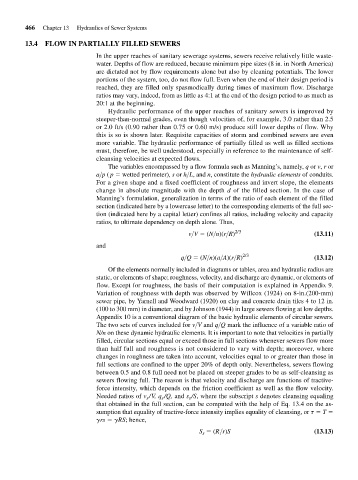Page 508 - Fair, Geyer, and Okun's Water and wastewater engineering : water supply and wastewater removal
P. 508
JWCL344_ch13_457-499.qxd 8/7/10 8:49 PM Page 466
466 Chapter 13 Hydraulics of Sewer Systems
13.4 FLOW IN PARTIALLY FILLED SEWERS
In the upper reaches of sanitary sewerage systems, sewers receive relatively little waste-
water. Depths of flow are reduced, because minimum pipe sizes (8 in. in North America)
are dictated not by flow requirements alone but also by cleaning potentials. The lower
portions of the system, too, do not flow full. Even when the end of their design period is
reached, they are filled only spasmodically during times of maximum flow. Discharge
ratios may vary, indeed, from as little as 4:1 at the end of the design period to as much as
20:1 at the beginning.
Hydraulic performance of the upper reaches of sanitary sewers is improved by
steeper-than-normal grades, even though velocities of, for example, 3.0 rather than 2.5
or 2.0 ft/s (0.90 rather than 0.75 or 0.60 m/s) produce still lower depths of flow. Why
this is so is shown later. Requisite capacities of storm and combined sewers are even
more variable. The hydraulic performance of partially filled as well as filled sections
must, therefore, be well understood, especially in reference to the maintenance of self-
cleansing velocities at expected flows.
The variables encompassed by a flow formula such as Manning’s, namely, q or v, r or
a>p (p wetted perimeter), s or h>L, and n, constitute the hydraulic elements of conduits.
For a given shape and a fixed coefficient of roughness and invert slope, the elements
change in absolute magnitude with the depth d of the filled section. In the case of
Manning’s formulation, generalization in terms of the ratio of each element of the filled
section (indicated here by a lowercase letter) to the corresponding elements of the full sec-
tion (indicated here by a capital letter) confines all ratios, including velocity and capacity
ratios, to ultimate dependency on depth alone. Thus,
v>V (N>n)(r>R) 2/3 (13.11)
and
q>Q (N>n)(a>A)(r>R) 2/3 (13.12)
Of the elements normally included in diagrams or tables, area and hydraulic radius are
static, or elements of shape; roughness, velocity, and discharge are dynamic, or elements of
flow. Except for roughness, the basis of their computation is explained in Appendix 9.
Variation of roughness with depth was observed by Willcox (1924) on 8-in.(200-mm)
sewer pipe, by Yarnell and Woodward (1920) on clay and concrete drain tiles 4 to 12 in.
(100 to 300 mm) in diameter, and by Johnson (1944) in large sewers flowing at low depths.
Appendix 10 is a conventional diagram of the basic hydraulic elements of circular sewers.
The two sets of curves included for v>V and q>Q mark the influence of a variable ratio of
N/n on these dynamic hydraulic elements. It is important to note that velocities in partially
filled, circular sections equal or exceed those in full sections whenever sewers flow more
than half full and roughness is not considered to vary with depth; moreover, where
changes in roughness are taken into account, velocities equal to or greater than those in
full sections are confined to the upper 20% of depth only. Nevertheless, sewers flowing
between 0.5 and 0.8 full need not be placed on steeper grades to be as self-cleansing as
sewers flowing full. The reason is that velocity and discharge are functions of tractive-
force intensity, which depends on the friction coefficient as well as the flow velocity.
Needed ratios of v s /V, q s /Q, and s s /S, where the subscript s denotes cleansing equaling
that obtained in the full section, can be computed with the help of Eq. 13.4 on the as-
sumption that equality of tractive-force intensity implies equality of cleansing, or t T
grs gRS; hence,
S s (R>r)S (13.13)

